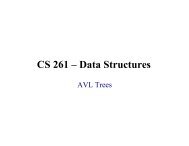Engineering Education and the Development of Expertise - Classes
Engineering Education and the Development of Expertise - Classes
Engineering Education and the Development of Expertise - Classes
Create successful ePaper yourself
Turn your PDF publications into a flip-book with our unique Google optimized e-Paper software.
100 (January 2011) 1 Journal <strong>of</strong> <strong>Engineering</strong> <strong>Education</strong><br />
Two hundred sixteen students submitted both reflections. Their responses were analyzed<br />
by Ogilvie <strong>and</strong> an experienced colleague based on a scheme that divided <strong>the</strong> problem<br />
solving approaches students described into two categories: “limiting” <strong>and</strong> “expansive.”<br />
Limiting strategies included equation matching, listing knowns <strong>and</strong> unknowns, <strong>and</strong> using<br />
prior examples. Expansive strategies included thinking about re-representing <strong>the</strong> problem<br />
with a diagram, thinking about concepts first, using qualitative analysis, <strong>and</strong> identifying<br />
sub-problems. The major conclusion from <strong>the</strong> analysis is that using <strong>the</strong> multifaceted problems<br />
led to significant <strong>and</strong> substantial increases in <strong>the</strong> number <strong>of</strong> students who described<br />
<strong>the</strong>mselves as using expansive strategies in solving problems.<br />
Model-eliciting activities. Model eliciting activities (MEAs) that promote deep<br />
approaches to learning were first developed in ma<strong>the</strong>matics education (Lesh & Doerr, 2003).<br />
MEAs are being adapted to engineering education by several groups, see e.g., Diefes-Dux <strong>and</strong><br />
Imbrie (2008) <strong>and</strong> Moore et al. (2008). The overall goal <strong>of</strong> MEAs is to facilitate <strong>the</strong> development<br />
<strong>of</strong> conceptual foundations <strong>of</strong> knowledge that will support deeper underst<strong>and</strong>ing (Lesh et<br />
al., 2000). Diefes-Dux, Verleger, Zawojewski, <strong>and</strong> Hjalmarson (2009) define MEAs as<br />
“open-ended, realistic, client-driven problems set in engineering contexts requiring teams <strong>of</strong><br />
students to create a generalizable (shareable, reusable, modifiable) ma<strong>the</strong>matical model for<br />
solving <strong>the</strong> client’s problem.” One <strong>of</strong> <strong>the</strong> distinguishing features <strong>of</strong> <strong>the</strong> MEA approach is that<br />
it incorporates multiple points <strong>of</strong> formative feedback <strong>and</strong> iteration to help students develop<br />
strategies <strong>and</strong> methods to solve such problems (Verleger & Diefes-Dux, 2008).<br />
The design <strong>of</strong> <strong>the</strong> problems <strong>the</strong>mselves is guided by six principles from Lesh, Hoover,<br />
Hole, Kelly, <strong>and</strong> Post (2000): (1) Reality: <strong>the</strong> activity provided should occur in “real life”;<br />
(2) Model construction: <strong>the</strong> activity must create <strong>the</strong> need to develop, revise, refine, <strong>and</strong> extend<br />
a ma<strong>the</strong>matical model; (3) Self-assessment: students should determine <strong>the</strong>mselves if<br />
<strong>the</strong>ir solution meets <strong>the</strong> criteria for success, <strong>of</strong>ten described as needs <strong>of</strong> a client; (4) Model<br />
documentation: <strong>the</strong> documentation required <strong>of</strong> <strong>the</strong> students should reveal <strong>the</strong>ir thinking;<br />
(5) Generalizability: <strong>the</strong> activity should guide students to develop <strong>the</strong>ir model in a way that<br />
will allow o<strong>the</strong>rs to not only use it to solve <strong>the</strong> immediate problem but also use it for <strong>the</strong>ir<br />
own purposes; (6) Effective prototype: <strong>the</strong> activity should involve learning processes <strong>and</strong><br />
knowledge that students will use in <strong>the</strong>ir academic <strong>and</strong> pr<strong>of</strong>essional careers.<br />
MEAs encourage deep engagement by dem<strong>and</strong>ing production <strong>and</strong> justification <strong>of</strong> a ma<strong>the</strong>matical<br />
model. The problems are cast in a realistic context that should enhance student interest<br />
<strong>and</strong> motivation. The method also helps students to develop <strong>the</strong> ability to assess <strong>the</strong>ir progress<br />
toward a successful solution, an important meta-cognitive skill. (MEAs can be considered a<br />
specific type <strong>of</strong> problem-based learning, which we address directly in <strong>the</strong> next section.)<br />
Purdue University began <strong>the</strong> process <strong>of</strong> integrating MEAs in a required first-year engineering<br />
class in 2002. Diefes-Dux <strong>and</strong> Imbrie (2008) describe <strong>the</strong> implementation process,<br />
which continues today with cycles <strong>of</strong> assessment <strong>and</strong> improvement. The overall goal for<br />
<strong>the</strong> implementation <strong>of</strong> MEAs was to “bring engineering content <strong>and</strong> contexts into <strong>the</strong><br />
first-year to help students better underst<strong>and</strong> <strong>the</strong> nature <strong>and</strong> practice <strong>of</strong> engineering <strong>and</strong> to<br />
better prepare students for <strong>the</strong> sophomore year while addressing a number <strong>of</strong> ABET criteria”<br />
(p. 56). The learning objectives for <strong>the</strong> course that are fulfilled through <strong>the</strong> use <strong>of</strong><br />
MEAs were: develop a logical problem solving process, translate a written problem statement<br />
into a ma<strong>the</strong>matical model, solve fundamental engineering problems using computer<br />
tools, <strong>and</strong> work effectively <strong>and</strong> ethically as a member <strong>of</strong> a technical team.<br />
The implementation presented many challenges because <strong>the</strong> enrollment <strong>of</strong> <strong>the</strong> class is<br />
typically in excess <strong>of</strong> 1,400 students. The class format includes two 50-minute lectures <strong>and</strong><br />
133
















